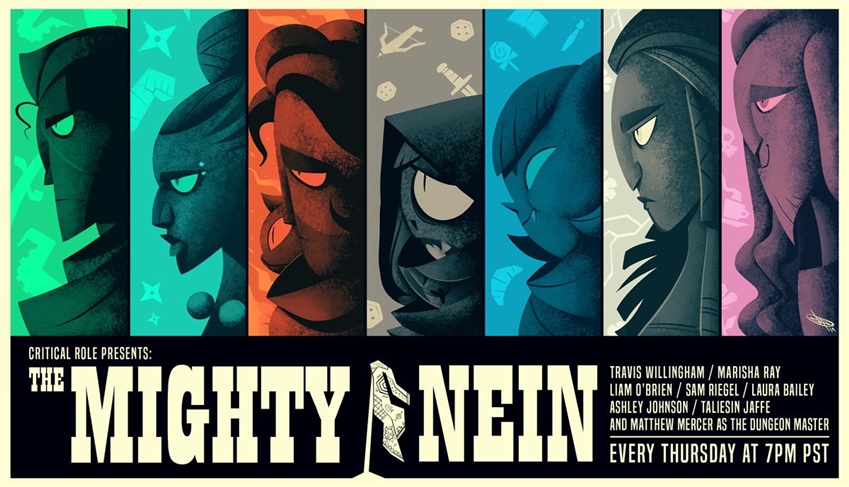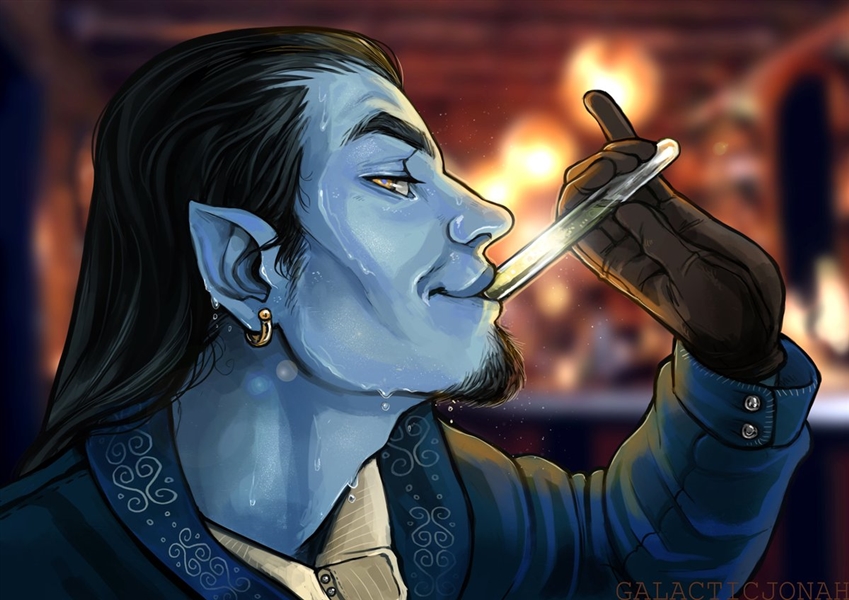This week’s episode of Critical Role was packed to the brim with unexpected events, but this spotlight is going to take a look at one of the less spoileriffic events: finding an NPC patron. Player characters can benefit immensely from being endorsed by powerful NPCs, especially at low levels, but this device can also serve the Dungeon Master by providing an easy way to insert their own agenda into the campaign.

Art by David Rodrigues (@3rdclover)
Episode Summary
Previously on Critical Role, the Mighty Nein placed another orb of Uk’otoa in its intended “keyhole,” and Fjord finally decided he’d had enough of the sea for a while. He set the Ball Eater on a course back to Nicodranas and relinquished command of the ship to Orly. The Mighty Nein said their farewells to the crew and faced a new day back on land.
This episode, the Mighty Nein disguised themselves and entered Nicodranas, hoping that their makeup and illusions would conceal them from the watchful eye of the Zelezho guard. After it seemed no one was paying them any mind, they decided to go shopping! Caduceus went to a local blacksmith, Ingots & Hammers, and learned that the broken blade he acquired several weeks ago was actually Uthodurnian in make. Inquiring further, he learned that Uthodurn is a “dual society” of elves and dwarves living in the Savalirwood, not actually that far from Caduceus’s home! Caleb went to a bookstore, of course.
Once reunited, the Nein returned to the Lavish Chateau and met with the Ruby of the Sea. Jester warmly embraced her mother, and recovered her rambunctious blink dog, Nugget. Now, tying up loose ends, the party went to investigate Tidepeak Tower, the mystical tower in the Open Quay that seemed to grow to immense size as an observer drew closer. After some negotiation with a goblin butler, they spoke with the tower’s master, Yussa, a mighty elven archmage who had been studying magic within the tower’s walls for over two centuries. They revealed the dungeon-containing sphere and the mysterious Xhorhasian beacon that they called the dodecahedron. Yussa revealed that the beacon was completely unlike anything he had ever seen before, and called its magic “alien.”
Yussa showed an interest in Caleb, and offered to him the potential of expanding his trust. He suggested that, if he and his friends showed themselves to be reliable, brought more interesting artifacts his way, and perhaps undertook quests that he could not complete without leaving the safety of his tower, he would extend more of his hospitality and knowledge to them. He showed Caleb the runic sigil that linked to his personal teleportation circle, even though it would be some time before Caleb mastered that spell.
Their business in Nicodranas complete, the Mighty Nein departed. They traveled back into the Empire through the Wuyun Gorge and traveled up north to Felderwin—a town they heard had been caught in a surprise attack by Kryn forces tunneling under the mountains. Beau sent a message to a friend of hers (probably not a girlfriend, but possibly an old fling?), who she had last seen in Trostenwald after the first gathering of the Mighty Nein: Dairon. She learned that she had been wounded in a skirmish and was recovering in Bladegarden, further to the east.
Upon reaching Felderwin, Caleb shrunk back into the cart in horror. Several archmages of the Cerberus Assembly were walking about the scorched town in broad daylight. This mages—the peers of his cruel tutor Trent Ikithon—were an immediate danger to Caleb’s safety, and by extension, the rest of the Nein’s. Nott sought out her old “friend” in the village, an alchemist named Yeza, and discovered a terrible secret within his burned-out house. They found research notes regarding experiments involving a second Xhorhasian beacon, and a brief primer on a magical force called dunamis and the magic used to manipulate it, dunamancy. Supposedly, this magic gave a dunamancer control of gravity, entropy, and time.
Nott frantically met with her hidden (and probably adopted) son, a young halfling boy named Luke. Now the truth of Nott’s trauma is beginning to be revealed: she no longer wishes to be a goblin, but not simply because she hates the rest of her kind (though she does), but because she wants her family to look at her with love, not fear and disgust. The rest of the Mighty Nein moved their cart into a hiding spot, and two cloaked members of the Cerberus Assembly plodded towards the alchemist’s shop…
Spotlight: NPC Patrons
Yussa, the archmage of Tidepeak Tower in Nicodranas, may be an excellent patron for the Mighty Nein, but he is not their first NPC patron. Back in Zadash, the Mighty Nein performed several vital tasks for the Gentleman, earning great rewards and his continued favor. A patron is different from a mere questgiver. Since this is a D&D campaign and not a video game, we have the ability to be more flexible with the roles our NPCs serve. Rather than simply handing out quests in a scripted sequence and gaining reputation points which unlock secret shops or some nonsense (though, having played years of World of Warcraft, it’s quite satisfying nonsense), NPC patrons are a powerful character that your party has the chance to form a mutually beneficial relationship with. Doing quests in exchange for gold and magic items is just the tip of the iceberg.
Yussa said to Caleb that he might show the scruffy wizard and his friends more of his tower as they earned his trust. The Gentleman knows that being part of a crime family means protecting your own. Part of creating a relationship with a powerful NPC means figuring out how much you can ask of them. Can you call upon them to fight an ancient red dragon in your hour of need? Vox Machina was able to call upon Arcanist Allura Vysoren, who had been their patron at early levels, to battle the dragon Thordak when the time was right.
Patrons can serve heroes by giving them rewards, lending their aid in times of crisis, revealing hidden information about the world, and more. Likewise, DMs can benefit from the use of patrons by handing out interesting quests to keep the party from getting too sidetracked, by revealing pertinent lore about world or significant items, and as a useful pacing tool to break a campaign up into easily digestible short adventures.

Art by Jonah (@GalacticJonah)
For DMs: Creating an NPC Patron
A good NPC patron requires several important ingredients. First, the patron must be likeable and memorable to your players. If your players don’t want to form a relationship with your patron, there’s no point. They’ll simply ignore your character and put their focus on someone else instead. A likeable patron doesn’t necessarily mean a capital-G “Good” patron, either. There are plenty of obnoxious, unlikeable paladins and suave, charming rogues in the world. And even if your patron is secretly planning to double-cross the party, they need to gain the characters’ confidence, don’t they?
My best advice is to build your patron with character first in mind and purpose second. If your character is just a walking, talking plot device, the player characters won’t bond with them. If you’re having trouble with this, rolling for Traits, Ideals, Bonds, and Flaws as if they were a player character is a great starting point for creating memorable NPCs.
Next, your patron must be powerful. A patron with nothing to offer doesn’t attract many adventurers. Power comes in many different forms, too. A lone, wandering barbarian has plenty of brute strength. The captain of a knightly order commands the might and respect of all their knights. A cunning politician has the full force of the law behind their words. Of course, a mighty archmage possesses the power to alter reality with a word and a gesture. And the master of a clandestine criminal network has dozens of rogues, blackmailers, and bruisers at their beck and call.
Third, the patron needs to be motivated. If your patron doesn’t want something, why are they looking for adventurers? The best patrons have motivations that are crystal clear to you, but obscure to the players. That way, you can subtly play out their schemes while leaving your players to guess at what they might be. This ties back into making your patron memorable; if the players want to unravel your NPC’s mysterious motivation and backstory, they’ll be more inclined to continue building a relationship with them in order to learn it.
Matthew Mercer is a master at weaving mysteries into his NPCs. The Gentleman is a shining example of this. We won’t get into spoilers down here, but this smiling, conniving sociopath is hiding something. Probably a lot of things. Even though the Mighty Nein are busy elsewhere, it’s clear that they will return to him in the future.
What lessons can we learn from Matthew Mercer and the Mighty Nein next week? Is it Thursday yet?
Unless otherwise credited, all images in this article are courtesy of Chris Lockey and Critical Role.
 James Haeck is the lead writer for D&D Beyond, the co-author of Waterdeep: Dragon Heist and the Critical Role Tal'Dorei Campaign Setting, the DM of Worlds Apart, and a freelance writer for Wizards of the Coast, the D&D Adventurers League, and Kobold Press. He loves watching Critical Role and wants everyone he knows to get into it, too. He lives in Seattle, Washington with his partner Hannah and his very own Frumpkins, Mei and Marzipan. You can usually find him wasting time on Twitter at @jamesjhaeck.
James Haeck is the lead writer for D&D Beyond, the co-author of Waterdeep: Dragon Heist and the Critical Role Tal'Dorei Campaign Setting, the DM of Worlds Apart, and a freelance writer for Wizards of the Coast, the D&D Adventurers League, and Kobold Press. He loves watching Critical Role and wants everyone he knows to get into it, too. He lives in Seattle, Washington with his partner Hannah and his very own Frumpkins, Mei and Marzipan. You can usually find him wasting time on Twitter at @jamesjhaeck.








-
View User Profile
-
Send Message
Posted Jan 18, 2019What happened to the actual storyline?
-
View User Profile
-
Send Message
Posted Jan 18, 2019Do you mean the episode summary? It's still up there, underneath the spoiler tag.
-
View User Profile
-
Send Message
Posted Jan 18, 2019Enjoying the new series a lot. I like the idea of the patron over a one dimensional quest giver. They give a lot of flexibility and depending on party interaction they might become a trusted ally or a bitter rival. I'm interested to see if the Gentleman and Yussa intersect. That's another aspect of the patron NPC that adds layers to the story. If you have more than one power player in the party's path how do they interact if at all?
-
View User Profile
-
Send Message
Posted Jan 18, 2019This way of combining the summary with GM tips is something I can get behind. Keep up the great work!
-
View User Profile
-
Send Message
Posted Jan 19, 2019I'm likin the spotlights
-
View User Profile
-
Send Message
Posted Jan 19, 2019Dunamis ? Greek for Power. D is for Dynamite ... coming up with a name like 'Dunamancy' shows a genius DM at work. Looking forwards to this playing out ....
-
View User Profile
-
Send Message
Posted Jan 20, 2019This Spotlight is absolutely inspiring.
The Episode was amazing, but getting a deeper look into the behind the scenes of DMing and creating interesting NPCs is awesome.
Keep up the good work!
-
View User Profile
-
Send Message
Posted Jan 20, 2019Nice work again! Great illustration in using Yussa and the Gentleman.I'm lokig these a lot. Keep up the good work.
-
View User Profile
-
Send Message
Posted Jan 21, 2019nice to see this format. as to the episode, i still think that Mercer should have had a ship approach - see the name of the vessel and mistake the Ball Eater for a floating brothel. Would probably have drawn some interesting reactions from Jester at the least.
-
View User Profile
-
Send Message
Posted Jan 21, 2019Count my voice among the chorus of those who really like this new format.
-
View User Profile
-
Send Message
Posted Jan 23, 2019Another option for making memorable NPCs is to use the tables in DMG Chapter 4 where you have mannerisms and traits and even ideals tied to their alignment.
-
View User Profile
-
Send Message
Posted Jan 23, 2019As a new DM finding his feet, this is pure gold. Thanks, man for doing this. Your love of the game, the genre, adventure, narratives and the shole lot shines through like the light through the proverbial cracks! Awesome.
-
View User Profile
-
Send Message
Posted Jan 26, 2019The recap does very little justice, in fact none, to the bombshell moment of when Nott asked to see her son. All it said was that the kid was likely adopted. That is purely an assumption and had nothing to do with the story told. Everyone at the table had jaws dropped. Even earlier Nott told everyone Caleb could eff off. Recap missed that dramatic reveal of backstory as bad as possible
-
View User Profile
-
Send Message
Posted Jan 27, 2019isn't diaron the monk from the cobalt soul? we allready know this, right?